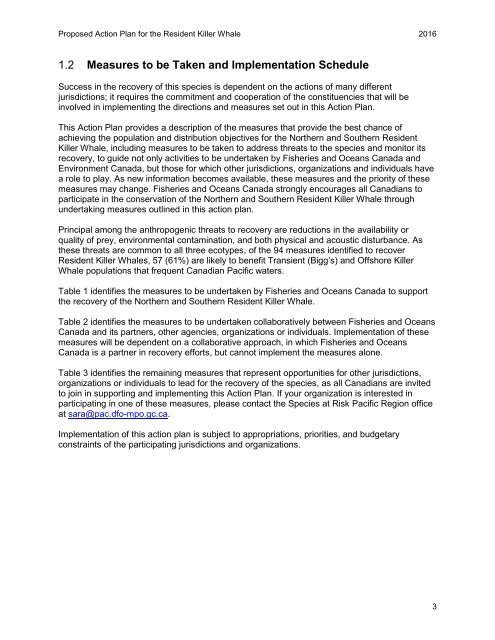Resident Killer Whale
Ap-KillerWhale-v00-2016Jun13-Eng
Ap-KillerWhale-v00-2016Jun13-Eng
Create successful ePaper yourself
Turn your PDF publications into a flip-book with our unique Google optimized e-Paper software.
Proposed Action Plan for the <strong>Resident</strong> <strong>Killer</strong> <strong>Whale</strong> 2016<br />
1.2<br />
Measures to be Taken and Implementation Schedule<br />
Success in the recovery of this species is dependent on the actions of many different<br />
jurisdictions; it requires the commitment and cooperation of the constituencies that will be<br />
involved in implementing the directions and measures set out in this Action Plan.<br />
This Action Plan provides a description of the measures that provide the best chance of<br />
achieving the population and distribution objectives for the Northern and Southern <strong>Resident</strong><br />
<strong>Killer</strong> <strong>Whale</strong>, including measures to be taken to address threats to the species and monitor its<br />
recovery, to guide not only activities to be undertaken by Fisheries and Oceans Canada and<br />
Environment Canada, but those for which other jurisdictions, organizations and individuals have<br />
a role to play. As new information becomes available, these measures and the priority of these<br />
measures may change. Fisheries and Oceans Canada strongly encourages all Canadians to<br />
participate in the conservation of the Northern and Southern <strong>Resident</strong> <strong>Killer</strong> <strong>Whale</strong> through<br />
undertaking measures outlined in this action plan.<br />
Principal among the anthropogenic threats to recovery are reductions in the availability or<br />
quality of prey, environmental contamination, and both physical and acoustic disturbance. As<br />
these threats are common to all three ecotypes, of the 94 measures identified to recover<br />
<strong>Resident</strong> <strong>Killer</strong> <strong>Whale</strong>s, 57 (61%) are likely to benefit Transient (Bigg’s) and Offshore <strong>Killer</strong><br />
<strong>Whale</strong> populations that frequent Canadian Pacific waters.<br />
Table 1 identifies the measures to be undertaken by Fisheries and Oceans Canada to support<br />
the recovery of the Northern and Southern <strong>Resident</strong> <strong>Killer</strong> <strong>Whale</strong>.<br />
Table 2 identifies the measures to be undertaken collaboratively between Fisheries and Oceans<br />
Canada and its partners, other agencies, organizations or individuals. Implementation of these<br />
measures will be dependent on a collaborative approach, in which Fisheries and Oceans<br />
Canada is a partner in recovery efforts, but cannot implement the measures alone.<br />
Table 3 identifies the remaining measures that represent opportunities for other jurisdictions,<br />
organizations or individuals to lead for the recovery of the species, as all Canadians are invited<br />
to join in supporting and implementing this Action Plan. If your organization is interested in<br />
participating in one of these measures, please contact the Species at Risk Pacific Region office<br />
at sara@pac.dfo-mpo.gc.ca.<br />
Implementation of this action plan is subject to appropriations, priorities, and budgetary<br />
constraints of the participating jurisdictions and organizations.<br />
3


